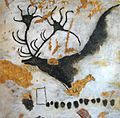Lascaux facts for kids
Lascaux is a famous cave located in the Vézère Valley in southwestern France. It is known worldwide for its incredible cave paintings. These paintings were made by early humans long, long ago.
The cave is near the village of Montignac in the Dordogne area. Lascaux holds some of the best examples of Upper Paleolithic art. Most of the paintings show realistic images of large animals. We know from fossils that these animals lived in the area at that time. In 1979, Lascaux became a UNESCO World Heritage Site. It is part of the "Prehistoric Sites and Decorated Caves of the Vézère Valley."
Montignac is about 40 kilometers from Périgueux. It is also about 25 kilometers from Sarlat-la-Canéda.
Contents
Dating the Lascaux Cave Paintings
It is tricky to figure out the exact age of the Lascaux paintings. This is because the colors used were not made from coal. So, we cannot directly date the paint itself.
However, Lascaux was one of the first places where radiocarbon dating was used. Scientists dated the coal found in old fireplaces inside the cave. This coal was about 17,000 years old. Some experts, like H. Breuil, thought the site might be older, perhaps 31,000 to 22,000 years old.
Norbert Anjoulat studied the style and themes of the paintings. He found they were similar to the Solutréen period, not the Magdalénien period.
There are still some debates about the exact dates. The paintings seem to be from 17,000 to 15,000 years ago. But some tools found in the cave appear to be older. The first estimates suggested an age of about 26,000 years.
Most archaeologists now agree that the age of about 17,000 years is correct. Here are the main reasons:
- All the paintings in the cave seem to be from roughly the same time.
- No objects have been found that would make the paintings older than 22,000 years.
- The tools found in the cave match those used between 17,000 and 15,000 years ago.
- All radiocarbon dating results point to an age of about 17,000 years. This matches the other findings.
Discovery and Challenges at Lascaux
The amazing Lascaux caves were discovered on September 12, 1940. After they opened to the public, about 2,000 people visited them every day by 1955. This many visitors caused problems for the ancient paintings.
In 1968, the original cave had to be closed to protect the art. An air conditioning system was put in place to help preserve the cave. The paintings were carefully restored. To allow people to still see the art, copies of several paintings were made in nearby caves. These copies are known as Lascaux II and Lascaux III. Today, the original cave is not open to the public.
Around the year 2000, a new problem appeared. Certain kinds of fungi started to grow in the original cave. These fungi were very hard to get rid of with normal fungicides. This was because the fungus worked with a special bacterium that could destroy the fungicide. So, scientists had to combine the fungicide with an antibiotic to kill both the fungus and the bacterium.
By 2006, the situation was mostly under control. The original caves are now sprayed with this special fungicide and antibiotic mix every two weeks. Special workers also carefully clean the cave walls by hand. They remove any fungus that still tries to grow, even with the treatment.
Images for kids
-
A painting of a Megaloceros with a line of dots
See also
 In Spanish: Cueva de Lascaux para niños
In Spanish: Cueva de Lascaux para niños







